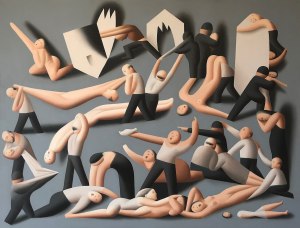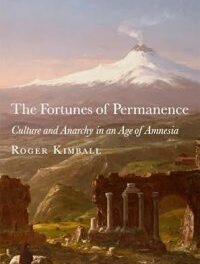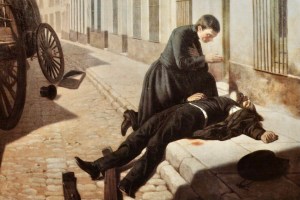We support our Publishers and Content Creators. You can view this story on their website by CLICKING HERE.
The intellectual virtues are not enough. Christendom’s rich Catholic culture must continue to be born anew each day from prayer and the liturgy, be constantly ordered to the sacraments, and continue to develop in accord with the Church’s two thousand years of experience in forming its people.
On July 1, 2024, Dr. George Harne took over as Christendom College’s fourth president. With an impressive academic background and a strong commitment to the liberal arts, Dr. Harne has demonstrated exemplary leadership and vision throughout his career. Here he reveals his aspirations for the college, his insights into the evolving landscape of higher education, and his plans to uphold and enhance Christendom’s vibrant Catholic academic community.
Christendom College champions a Catholic liberal arts education surrounded by a culture that reflects what is learned in the classroom. How do you plan to ensure this tradition continues to thrive?
As a musician, I tend to think in terms of musical structures. A vibrant, faithful, intellectually rich Christendom College will be a lot like a great symphony orchestra. In an orchestra, each section of instruments plays its proper role and is prepared to perform at the highest professional standards. But each section must contribute its part to the overall creation of a single composition, listening to and blending with the other sections to form a dynamic and harmonious unity. Some sections play the melody while others play the supporting—but absolutely essential—harmony. And of course, the conductor has a role to play.
In order for the College’s tradition of integrating its intellectual and cultural dimensions to continue to thrive, all the elements of the College will need to continue to be “in tune” and in harmony. This analogy can be applied to the different types of formation that the College offers. We form our students intellectually, spiritually, and socially. And our formation is deep, sustained, and integrated, one that distinguishes Christendom College alumni from those of every other college. Ultimately, Christendom will fulfill its mission best when its parts are in a hierarchical harmony, animated by fidelity and charity, and ordered to their proper end. This is the best way to ensure that this tradition continues.
In a 1991 newspaper interview, college founder Dr. Warren Carroll said, “We were founding a Catholic college and had no doubt what that meant.” How do you envision maintaining and furthering the college’s commitment to Catholic identity and academic excellence? And how will these commitments inform the college’s mission?
There are three touchstones to which we must be constantly returning. First, there is the particular founding vision of Christendom College—its particular DNA—and the organic and historical development of that founding vision. Since every truly important founding is complex and an inexhaustible source of reflection, we must keep the founding vision constantly in view but not in a superficial way. We must not let it become a cliché. Instead, we must ever seek to deepen our understanding, teasing out the nuances and clarifying the distinctions, sifting to discover what is essential and what is accidental. And it is often the case that one part of the founding vision must be emphasized more at a given historical moment than another.
Second, there is the specific nature that belongs to all Catholic colleges and universities worthy of that name. With this touchstone we will look to magisterial teaching about Catholic higher education—Fides et ratio, Ex corde ecclesiae, and Benedict XVI’s address at the Catholic University of America in 2008. We will also look to the writings of Josef Pieper, Cardinal Newman, and the writings of others who have reflected deeply on the nature of Catholic higher education. This touchstone will include the full range of ancient and medieval wisdom as well. We must never stop reflecting on these sources. All of these thinkers can help us clarify the specific nature of Christendom College.
And third, we will look with charity to the needs and opportunities of our present age. We must first clarify these needs and opportunities through dialogue with those who are wise about such matters. My hope is that over the next year we can engage a wide variety of Catholic friends and leaders across the nation in this dialogue. We will listen to alumni, friends of the college, faithful leaders in the Church and society, and enlarge the conversation to include many others. And through these efforts we will determine how Christendom can set the pace and lead with courage and prudence where such opportunities present themselves. The perennial truths have not changed but our world has changed.
At the same time, however, this leadership cannot become degraded into a kind of restless activism that wears away the contemplative foundation that must be at the heart of all that we do. Martha’s work was essential, but Mary chose the better part.
I believe that Christendom can—if we remain true to our particular founding, our specific nature, and see the present moment with absolute clarity—become the place to which thoughtful people from across our nation (and beyond) will look for wisdom and direction. Christendom can become the source that illuminates, nourishes, guides, and challenges those who will shape our future. And Christendom alumni will take this light and wisdom to the four corners of the globe, wherever God may call them. And once there, they will do the work God has called them to do.
Finally, just as there can be no place for institutional infidelity, we also must strive to give no place to mediocrity, either in our academic life or in any other dimension of our work. We are called to be good stewards of the full patrimony of the Catholic intellectual tradition and to be nourished by the liturgical, spiritual, and cultural treasures of the Church and historic Christendom.
Can you share your vision for Christendom College’s role in shaping future leaders within the Church and society?
In a nutshell, we were founded to “form and send.” Each of these verbs contains a multiplicity of activities and possibilities. And there are the particular ways that Christendom forms and sends her students. It is not a cookie-cutter or reductive approach.
The formation we offer encompasses both the intellectual and moral virtues. And as a college we give a particular accent to the intellectual virtues. I am fond of the image—attributed to Newman—of the experience of liberal education being like a man who lives in a town near a high mountain. He has grown up in the town and knows it like the back of his hand. But one day he climbs the mountain and comes to see not only the town in a new way—as a whole and from above—but also within the much broader context, catching sight of other towns and even other mountains. But it does not end there. After he returns to his town, his vision is forever changed. His view of the part is forever mediated by his integrated view of the whole. And his vision is marked by humility. For while he may now have an integrated and expansive vision, he also knows how limited his previous vision had been and how much more he still has to learn. Forming such a vision in the heart and mind of each Christendom student is central to shaping future leaders for the Church and society.
But the intellectual virtues are not enough. Cardinal Newman understood very well that liberal learning was not sufficient to shape the will and character of students. And it is here that the other types of formation become central. Christendom’s rich Catholic culture must continue to be born anew each day from prayer and the liturgy, be constantly ordered to the sacraments, and continue to develop in accord with the Church’s two thousand years of experience in forming its people.
And with all of this, we are only beginning. If we do our work well, our alumni will undertake their own formation over the course of their lives.
But when we form our students we must also send them. If “Christendom” can be considered any place where Christ is honored as king, our students will not only seek to order their own lives and the lives of their families around Christ but will also seek to extend Christ’s reign in their parishes, communities, and the places where they work professionally.
How can Christendom send its students in order to fulfill its founding mission?
Two ways immediately come to mind: through partnerships and pathways. Every year, new initiatives within the ecclesial, non-profit, and professional worlds emerge with which Christendom could become a partner, collaborating as an institution to further the College’s mission while building up the common good.
And through such partnerships—formal and informal—we can create pathways for our graduates. Most of our alumni will serve faithfully and heroically in places that are more hidden, just offstage, and out of the limelight. They will be salt and light, fulfilling their vocations without public fanfare. But others will have more public roles and make decisive and pivotal decisions that will redirect the fundamental currents that shape our lives over the course of generations. Are there Christendom graduates serving and leading in the public sector at every level of govern-ment? Are there Christendom graduates creating and shaping media and popular culture? Are there Christendom graduates in the pivotal fields in higher education? And are Christendom graduates founding and leading the companies that will shape our economic future in ways that are fitting for human flourishing? Yes, we have made a beginning in sending our graduates into these places, but more can be done. We cannot give up on these institutions of media, government, higher education, and economic life. We must renew them by sending those whom we have formed.
What excites you most about leading Christendom College?
Above all, the people. I am thrilled to do everything in my power to advance the mission of the college within a community of students, scholars, administrators, staff, and trustees who love the Church and love the Catholic intellectual tradition. The people are what make Christendom the very best place one could hope it to be.
How has your conversion to Catholicism impacted your approach to education?
When my wife and I converted to Catholicism, everything changed. It was a spiritual conversion but also an intellectual one. Every aspect of our lives changed, and new sources of meaning, practices, perspectives, and even new foods became central to our lives. Before our conversion, my approach to education was largely a crazy quilt of ideas that I had discovered or received from my academic training. Entering the Church and discovering the intellectual riches of the Catholic intellectual tradition redefined every aspect. I learned to think in terms of natures and ends both with respect to students but also institutions. But I also developed a recognition of the mystery at the heart of teaching, learning, and scholarship. And I came to see—thanks to Newman—the activities of the scholar and teacher in a completely new light. I’ve only begun to scratch the surface of the tradition and one lifetime will not be enough even to begin to enter into it.
What is your favorite book and what’s on your nightstand now?
I return to Dante and the Divine Comedy almost every year. I do have a daughter named Beatrice, after all. My wife and I have an almost three-decade long dispute about whether Thomas Mann’s greatest novel is Doctor Faustus or Magic Mountain. (I am a partisan of the former.) My nightstand is creaking under the weight of a large stack of books. Among them are Pierre Manent’s Metamorphoses of the City, the annotated edition of Lewis’ Pilgrim’s Regress, Christopher Shannon’s American Pilgrimage, Gilson’s Dante and Philosophy, and Leon Bloy’s The Woman Who was Poor.
What is your favorite film?
This is a tough one. I have several favorites. In graduate school I watched everything I could by Kurosawa, Bergman, and Fellini. And I’ve always been interested in the earliest years of film when there was such a fruitful exchange between filmmakers such as Jean Cocteau and Sergei Eisenstein and composers such as Elliot Carter. But I keep returning to On the Waterfront, which is great in so many ways, and as a musician I’m particularly fond of Bernstein’s soundtrack. Among the work of more recent filmmakers, I’ve enjoyed Terrence Mallick’s Tree of Life and A Hidden Life. More recently we watched Interstellar with my older kids. It is also one of my favorites.
Your background is in music and music history. Can you recommend any composers or pieces that should be on everyone’s playlists?
I always enjoy introducing students to the American art-music tradition, especially the music of Aaron Copland, the early works of Elliot Carter, and the music of Samuel Barber. As a kid I discovered Copland’s Appalachian Spring, Rodeo, and Billy the Kid. But I find his chamber music, especially the Piano Variations, Sextet, and Violin Sonata to be perennially rewarding. As a medievalist, I never tire of the music of Machaut, Ciconia, and Dufay.
What individuals have had the greatest influence on your personal and professional journey?
I have learned the most from my wife, but I have also been shaped by my teachers and friends. And I’ve learned so much from my children. I thought that I would be one of the primary teachers in our family, but it turns out that I’ve also been one of the primary students.
Republished with gracious permission from Christendom College.
The Imaginative Conservative applies the principle of appreciation to the discussion of culture and politics—we approach dialogue with magnanimity rather than with mere civility. Will you help us remain a refreshing oasis in the increasingly contentious arena of modern discourse? Please consider donating now.
The featured image, uploaded by APK, is a photograph of Christ the King Chapel at Christendom College in Front Royal, Virginia. This file is licensed under the Creative Commons Attribution-Share Alike 4.0 International license, courtesy of Wikimedia Commons.

 Conservative
Conservative  Search
Search Trending
Trending Current News
Current News 






